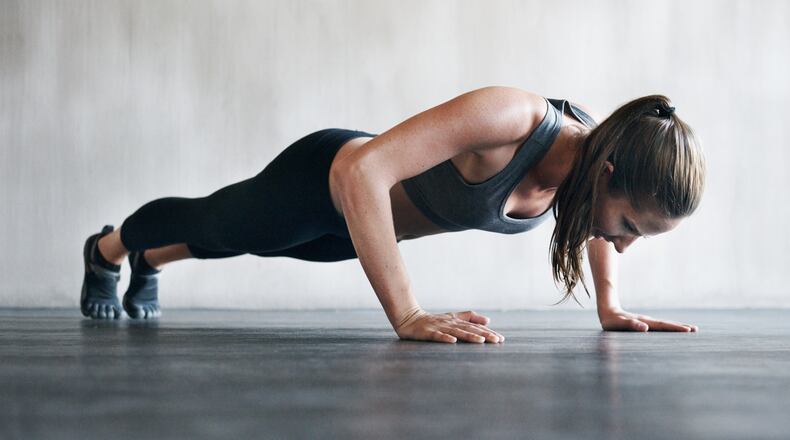There are many variations of the pushup, which can help alleviate boredom. Beginners can start by performing the exercise against a wall, or on the floor with knees bent. Advanced exercisers can do them on the floor with legs straight or elevated.
- Basic floor pushup: Position yourself with arms slightly wider than shoulder-width apart and legs straight. Without bending at the waist slowly lower toward the floor by bending the elbows, until the chest is close to the floor. Then push yourself back up until your arms are straight again. With all versions of the pushup, it is important to avoid rounding or swaying the back or arching the neck. Instead, keep your body tight and use steady controlled speed of movement. If pushing the entire body weight is too difficult, Bent-knee pushups are an option: Here, technique is the same as the basic pushup, but knees are bent.
- Standing pushup: (beginner) Standing, place your hands on a wall, desk, table, countertop or other sturdy elevated surface. The lower the area you are pushing against and the further back your feet are, the harder the exercise becomes. If you are unaccustomed to resistance exercise, start by doing wall pushups to gauge your strength. Tip: Standing pushups are perfect for outdoor exercise, too. You can use the back of a park bench, end of a picnic table, or against the side of the pool.
- Decline pushup: (advanced) Place the feet on an elevated surface such as a bench, chair or stability ball. Keep your legs straight as you lower your chest to the floor and push back up.
- One-arm pushup: (Most advanced) It takes extreme strength to perform a one-arm pushup. This exercise uses the same technique as the basic pushup but uses only one arm to lower and push.
Beginners can start with two sets of eight to 12 repetitions every other day or every third day to help gauge strength and become familiar with proper technique. Additional sets or repetitions can be added as you get stronger.
Marjie Gilliam is an International Sports Sciences Master certified personal trainer and fitness consultant. She owns Custom Fitness Personal Training Services LLC. Send email to marjie@ohtrainer.com.
TIPS
- Don’t arch the back, lift or turn the head while performing pushups. Keeping the abdominals engaged will help to protect the low back. The amount of time that your muscles are under tension is important.
- Avoid using excessive speed/momentum and instead, use a slow controlled pace. A typical speed of movement would be about 2-3 seconds on both the lowering and pushing phases. The slower the speed of movement the more difficult the exercise becomes.
- Strengthening exercises such as pushups should be difficult enough so the muscles are fatigued, but you should never experience pain. Pain can be a sign of an existing joint injury or other condition, so listen to body signals and adjust your exercise program accordingly.
- If you are inexperienced with weight training exercises, it is advised to have a spotter, someone familiar with proper form and technique.
About the Author
